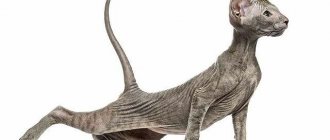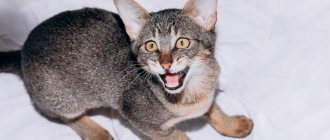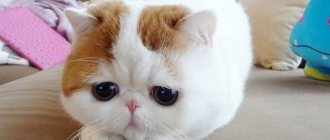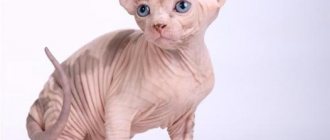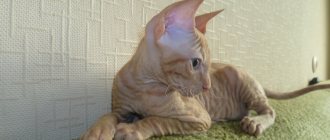Don Sphynx - a “greenhouse” and whimsical, inquisitive, affectionate, wise and sensitive creature. As a typical bald representative of the cat world, he will make a strong impression on everyone. But whether it will be positive or with a slight admixture of hostility is a big question.
Not everyone will like a pet with an original appearance that follows its owner around. The animal will wait for the right moment to jump on your lap and receive a portion of affection. But for those who treat the totality of his quirks with understanding, the Don cat will give a lot of happiness and love.
Caring for a newborn kitten
Introduction. Newborns, still blind and deaf, kittens give the impression of completely helpless creatures. They comically spread their paws in all directions and raise their heads with small ears, still pressed to the sides of their heads. They weigh from 70 to 130 g. The whole meaning of their life is still in their mother, or rather in her warm belly, with such delicious milky nipples. By the way, most kittens do not suck all nipples in a row, but choose one and use it for their pleasure. Having captured it in their mouth, they massage the mammary gland with their front paws, causing it to lactate more abundantly. At the same time, they fiercely defend their right to the nipple, pushing their own brothers and sisters away from it. The cat usually purrs loudly, and kittens, from approximately the second day of life, quietly “rumble” in response. While still not seeing or hearing anything, babies have a developed sense of smell and touch - they find their nipples by smell, and adjust their position relative to the cat using, among other things, thermal receptors. For the first 48 hours, kittens usually sleep with their heads bowed to their chests. In their sleep, they shudder, “kick their legs” and sometimes squeak. This is the so-called active sleep - and this is natural, because this is the only opportunity for the kitten to move a little, which contributes to the development of muscles that he will need later. Disturbed newborn kittens huddle together or crawl towards a source of warmth - their mother, awkwardly rising on their front legs and dragging their bellies with difficulty. A kitten accidentally falling out of the nest makes absolutely desperate sounds. Both the cat and the breeder react to this sound in exactly the same way - rushing to see what happened. Healthy kittens look round and plump. Their skin is pink and warm to the touch. If you pinch a kitten, the skin immediately returns to its original place. If you pick it up, it stretches out and swings vigorously in your palm. Unlike healthy ones, a sick baby is a pitiful sight. He can hardly move, he is cold to the touch and hangs like a rag when he is picked up. Taking a nipple into his mouth, he pushes it out and does not want to suck. Such kittens scream plaintively, shrilly and for a long time. Exhausted kittens are hyperactive - they crawl, looking for help, and fall asleep away from the warmth of their mother and littermates. They rest with their limbs spread out and their heads tilted to the side. These kittens are often rejected by their mother, who believes they will not survive. She pushes them out of the litter, saving her strength for healthy kittens. If the kittens are treated and their body temperature returns to normal, the cat will accept them. Healthy kittens rarely squeak. Typically, a kitten squeaks if it is cold, hungry, or in pain. A good mother instinctively guards the nest and keeps her kittens clean. At first, after giving birth, she generally tries not to leave the house. She feeds, licks the kittens, massages their tummies and the rectal area of each kitten with her tongue so that they can do “their business” and “cleans up” after them. But, already a couple of days after giving birth, she may be overcome by “wanderlust” and will try to drag the kittens to another secluded place. This is the so-called atavism - an instinctive program inherited from wild ancestors who needed to save their children from predators. And since after the birth there could be some traces left that could lure predators to the nest, the cat had to move the kittens to a new place.
Castration and sterilization
Differing in the mechanism of implementation, castration and sterilization are operations to artificially disrupt the reproductive function of an animal. Owners who do not want to have offspring from their pets resort to one of these methods. The advantages of these manipulations:
- the life expectancy of pets increases;
- the animal’s hormonal levels stabilize, it becomes calmer, stops making loud sounds and marking;
- the risk of such pathologies as ovarian cysts, inflammation of the uterus and some others is reduced.
Neutered animals produce less allergenic protein, which reduces the risk of adverse reactions in humans.
An animal needs sexual intercourse only to reproduce. Violation of reproductive function through surgical intervention does not negatively affect the health of the pet. Castration must be carried out before the onset of puberty.
Temperature of kittens at birth
The kittens' temperature is equal to the mother's temperature, but immediately drops by several degrees (much depends on the temperature in the room). Within 30 minutes, if the kitten is dry and snuggled close to the mother, the temperature begins to rise. Until three weeks of age it is 35.6-37.8°C. The temperature of a healthy kitten is 5-6°C higher than the environment. Cooling and overheating are the only dangerous factors that threaten the life of kittens. This can occur if the ambient temperature is around 21°C and the cat has left the nest for 30 minutes. With hypothermia, metabolic processes slow down in the kitten's body. In most kittens, the subcutaneous fat layer is poorly developed. In addition, they do not yet have a mechanism for thermoregulation. That is, they do not have a narrowing of the subcutaneous vessels to retain heat in the body. Kittens get all their energy from food, and since their reserve potential is small, they are forced to eat often. Otherwise, regardless of the reasons, they may develop hypothermia. Hypothermia is the greatest danger for kittens. During the first week of life, the temperature in the nest (box) and around it should be 29-32°C. Then it decreases weekly by 2.5°C until it reaches 21°C
Colors
The colors of hairless cats are varied. But due to the lack of wool, they do not look very bright. The colors themselves can be divided into several groups - solid, points, and patikolours. Solid or solid colors include:
- White. This color is found in all breeds. Don Sphynxes with this coloring may have cream shades than pure white.
- Black. In color painting it is called seal point. Black individuals have varying degrees of skin pigmentation. It can be from dark black to gray. When determining color, you need to examine the paw pads, nose and ear rims. Eyes can be any color.
- Blue. This color is a lightened version of black. May appear as baby blue or light grey.
- Red. This color cannot exist without tabby coloring. Newborn red kittens are often confused with cream kittens.
- Cream. Lightened version of red.
Tortoiseshell colors are unique to cats and there are several types of tortoiseshells:
- black tortoise is a combination of black and red colors;
- The blue turtle is a combination of cream and blue.
White sphinx.
Black Sphinx.
Blue Don Sphynx.
Red Sphinx.
Cream Sphynx.
Tortoiseshell color.
An important condition for determining the color of a turtle is the ability to distinguish it from a tabby-torby. The tortoiseshell color is a combination of black, red or cream. There are also other types of colors of Don Sphynxes:
- Chocolate. This variant is black in color, in the eastern group it is called “Havana”. This type of color is rare and atypical for Donetsk residents.
- Particolors. There are some variations of this color, calico and bicolor. This type is a tortoiseshell color with a combination of white. More than half should be white. Bicolors are a mixture of the main coat color and white. The proportion can be 9 to 1.
- Color points. These colors are found in all cat breeds and the Don Sphynx is no exception. It is a mixture of three or more colors in varying proportions.
- Tabby. Can be classic, spotted black, brindle.
The Don breed does not have different patterns on its body. It is extremely difficult to see them on naked animals.
Material on the topic: popular colors of the Scottish cat breed.
How to properly warm a chilled kitten
If a kitten's temperature is below normal (for its age), it is considered chilled. In this case, it is necessary to gradually warm it up. Rapid warming (for example, on a heating pad) causes vasodilation of the skin, increased heat loss, additional calorie consumption and a greater need for oxygen, which has a detrimental effect on the kitten. The best way to warm a kitten is to put it under your clothes, warming it with your own warmth. If the temperature is below 34.4°C and the kitten is weak, warming up will take 2-3 hours. Once warmed, he is placed in a home incubator and fed artificially (see artificial raising of kittens). Never feed or nurse a chilled kitten, as its stomach and small intestine will not function and therefore will not digest the food (there will be bloating and likely vomiting). A cooled kitten is given a 5-10% solution of glucose with water (1 ml per 30 g of kitten weight per hour) and gradually warmed up until it moves away and begins to move vigorously. Instead of a glucose solution, you can use a honey solution and, as a last resort, slightly sweetened water.
Tips for keeping your kitten healthy
Veterinarians recommend the following ways to maintain the health of a kitten:
- Study the movements and reactions of the kitten to immediately understand if he suddenly gets sick and immediately contact a veterinarian;
- Provide your kitten with proper nutrition by choosing a balanced diet appropriate for the animal’s age;
- Kittens need to sleep a lot, so provide your pet with a quiet and comfortable place to rest;
- Never wake a sleeping kitten;
- Take time to play with the kitten, as it needs communication and physical activity;
- Always stick to your vaccination schedule.
The first months of a kitten’s life are a time of intensive growth and development. By taking care of your pet's health at this stage, you can lay the foundation for a healthy kitten life in the future.
Source
Weight gain value
On average, a newborn kitten weighs 70-125 grams. Kittens should continually gain weight and double it by days 7-9. At 5 weeks, a kitten weighs on average 450 g, and at 10 - about 900 g. Kittens (from the first day of life) are weighed daily for the first two weeks, and then, up to 4 weeks, once every three days. Constant weight gain is the best indicator of normal kitten development. If he does not gain weight, a thorough examination is necessary. If several kittens in a litter do not gain weight, you can think about maternal factor (toxic milk, metritis or insufficient milk production). If the mother receives low-calorie food, she, accordingly, has low milk production. A cat during lactation requires 2-3 times more food than a regular adult cat. The diet must be balanced to compensate for the body's losses during lactation.
Nutrition for a nursing cat
During lactation, the cat's need for calories, depending on the number of kittens born, increases 2-3 times compared to the period before coating. During this period, the cat must receive high-quality, balanced food with a high protein content, otherwise she will quickly lose weight and not produce enough milk for her kittens. Lack of milk is the most common cause of death in kittens.
It is better to use ready-made food from reputable companies, designed for growing kittens. They are balanced in protein, fat and carbohydrates, along with vitamins and mineral supplements, and are quite suitable for lactating cats. The amount of food during lactation is not limited. If she has 4 or more kittens, she is not at risk of obesity. Dry food can always be near her. Wet food is given 3-4 times a day. The diet of a nursing cat is increased three times compared to the period before coverage. Vitamin and mineral supplements are not given, as they are part of the feed. They can be added only in cases where a nursing cat refuses industrial food, is weakened after suffering a chronic disease, or has hypovitaminosis that developed earlier. In all these cases, you should definitely consult a veterinarian.
History of the origin of the breed
The birthplace of the Don Sphinx is the Russian city of Rostov-on-Don. It is known that the kitten was found by university professor Elena Kovaleva. We can say that she simply saved the life of an animal that was being tortured by children. It looked like an ordinary cat, which she named Varvara. At home, she quickly settled in and came to her senses. And after a couple of months, she began to lose hair, which caused concern among the owner. After many examinations, the breeder came to the conclusion that hairlessness does not interfere with the baby’s life at all and does not bother her. The cause of hair loss was identified as a gene mutation. Having matured, Varvara brought offspring who completely adopted the genetic anomaly. Of all those born, only one cat was saved - Chita, who became the ancestor of the Don breed. The Don Sphynx cat breed received official status in 1996.
When do kittens need complementary feeding?
Kittens that continually gain weight during the first week of life are not in danger. Kittens should be monitored more closely as they lose up to 10% of their body weight in the first 48 hours of life, with further gain. Kittens that lose more than 10% of their body weight in the first two days and do not gain it by 72 hours are unlikely to survive. Start artificial feeding immediately (see artificial raising of kittens). If a kitten is born less than 25% of its expected weight or from littermates, it will usually die unless it is incubated and bottle-fed. It is possible to save many kittens that are developmentally delayed if they do not have other diseases or congenital malformations.
Artificial raising of kittens
Unfortunately, in our lives, sometimes unforeseen situations happen. And sad as it may be, no one is immune from the death of a beloved animal or the presence of serious postpartum complications, due to which the raising of newborn kittens falls entirely on the shoulders of the owner. The ideal solution in this case is a nursing cat. Almost always, a nursing cat accepts other people's kittens and takes care of them as if they were her own. And no matter how the nurse cat looks, it will not affect the length of the coat, eye color and other characteristics of the breed of your charges. To find a wet nurse, contact the club you are a member of, as well as your veterinarian. Perhaps they have a cat in mind that has recently given birth. Otherwise, you will have to artificially feed the kittens. However, in some cases, artificial feeding or additional complementary feeding is required for weakened kittens even with a healthy mother. The need for complementary feeding of a kitten is determined by its appearance, vitality, birth weight and size compared to littermates. As a rule, complementary feeding in such cases begins early and, as a last resort, is transferred to artificial feeding, without waiting for severe disorders. Depending on the general condition of the kitten and its reaction to complementary feeding, it can be supplemented 2-3 times a day, leaving it with its mother. The weakest kittens require special care and are raised separately. To preserve the life of kittens, three aspects are extremely necessary - the necessary temperature conditions, proper preparation and dosage of food and appropriate care. We should not forget that kittens that have not received colostrum, or their mother’s first milk, do not have passive immunity, therefore, they are susceptible to various diseases.
Choosing a mating partner
Shortly before breeding Canadian Sphynxes, you should definitely take the animals to the veterinarian to make sure that your cat does not have any diseases. In addition, approximately fifteen to twenty days before mating, both partners should undergo deworming for the purpose of prevention. This will allow your pet to receive a guarantee that pregnancy will not be complicated by the presence of worms.
Check your cat's readiness to bear offspring with a veterinarian
Immediately before mating, both the male and the female must trim their claws, otherwise the animals may injure their partner during the mating process. And keep in mind that you should never wash cats before breeding. This is explained by the fact that washing can destroy the real smell of the cat, which attracts the male, which, in the end, can result in a failed mating.
Possible complications
• Fading kitten syndrome The most dangerous days in a kitten's life are the first two weeks. In some cases, mortality is associated with birth trauma and other previously described factors. A weak, physically undeveloped kitten finds itself in a worse position after birth than other kittens. Due to low weight, lack of muscle mass and subcutaneous fat, such a kitten is not able to breathe deeply, actively suck and maintain body temperature. His birth weight is 25% lower than that of his littermates and he is most likely to be pushed away from the milkiest nipples. A hypothermic kitten that has stopped sucking and is dehydrated develops a shock-like condition caused by circulatory failure. The body temperature is below 34°C, and the heart rate and breathing rate drop. The ability to crawl and roll over on the stomach is gradually lost. The kitten lies on its side. Later, cerebrovascular accident leads to tetanic convulsions and coma, accompanied by short-term cessation of breathing - up to 1 minute. This condition is irreversible. Typically, low birth weight is caused by malnutrition in the womb. If all kittens lag behind in development, this is most likely due to poor feeding of the cat. If only one or two kittens in the litter are smaller than the others, then it is most likely due to placental insufficiency, incomplete abruption or unfavorable attachment to the uterus. Kittens in this case are physically underdeveloped due to disruption of intrauterine development, and not due to age. These kittens are artificially fed and raised in an incubator. Between 5 and 12 weeks of age, kittens are most susceptible to infections, particularly viral pneumonia. This is due to a decrease in passive (colostral) immunity and the absence of its own immune mechanism, including the absence of active post-vaccination immunity. If a cat has suffered viral or infectious diseases, then the kittens can become infected in utero. In this case, they are also born small and weak. Their condition worsens and they die within the first few days. The maternal factor is very important for the survival of kittens. Primiparous and obese cats lose more kittens after birth than experienced cats in good physical condition. The quantity and quality of a cat's milk are extremely important. Mother's milk can be toxic to kittens for a number of reasons. The primary cause is acute septic mastitis, inflammation of the mammary glands or abscesses (more details). Toxins in milk cause digestive upset in suckling kittens. This condition can also be caused by improperly prepared and stored infant formula. Toxic milk syndrome usually occurs in kittens one to two weeks old. The kittens are exhausted and constantly meow pitifully. The most common symptoms are diarrhea and bloating. The anus is often red and swollen due to acidic stool. A complication of this syndrome is kitten septicemia (blood poisoning). Kittens with bloat are weaned and treated for diarrhea and dehydration (see Common Feeding Mistakes). Cooled kittens are warmed and placed in an incubator. They are fed artificially. Call a veterinarian immediately. Hypogalactia is the most common cause of death in kittens. The number of kittens in the litter and genetic factors also play a big role, but in most cases mortality is associated with low caloric content and lack of nutrients in the cat's milk. Unfortunately, there are many other malformations of kittens that can lead to their death.
• Dehydration The kidneys of a newborn are functioning at 25% of the level of adult cats. A kitten's immature kidneys are unable to concentrate urine and therefore produce large amounts of undiluted urine (primary urine). If a kitten stops suckling, it quickly becomes dehydrated. Therefore, if the kitten is losing or not gaining weight, is hypothermic, or is too weak to nurse, consider dehydration. Increased renal fluid loss must be compensated by adequate intake of mother's milk or, if bottle-fed, commercial kitten milk containing adequate water. Sudden weight loss with diarrhea is associated with water loss. Signs of dehydration: dry mouth; the mucous membrane of the oral cavity and tongue is bright pink; decreased muscle tone and weakness. If you pinch a kitten, the skin fold remains instead of going back. Treatment for dehydration is the same as for diarrhea.
• Hemolysis Hemolysis is the death of kittens due to blood incompatibility. Not long ago, another explanation was received for the possible cause of death of newborn kittens. This problem is directly related to a topic that is still unfamiliar to our breeders - blood genetics. Blood groups are essentially antigen proteins located on the surface of red blood cells (erythrocytes). Unlike most species of warm-blooded animals, antibodies that bind foreign red blood cells are already present in the kitten’s blood at the time of birth. Although the patterns of inheritance of cat blood groups have not yet been sufficiently studied, it is known that the genes that carry this information are located nearby, on a certain chromosome. Cats are known to have three types of blood - A, B, AB. Unlike humans, they have not been found to have a zero blood group. Allele a is dominant over allele b. That is, a cat with blood type B is homozygous for the B allele. A cat with blood group A can be either homozygous or heterozygous for the a allele. Group AB is the rarest and least studied, but it is known that an animal with this blood type does not necessarily have parents with blood types both A and B. The most common blood type in cats is blood type A, which is dominant over B. Therefore, the consequence of this dominance is offspring who have type A blood, but often simultaneously become a “carrier” of type B blood. Antibodies of different blood groups are unequally active towards each other. Antibodies of blood group B actively bind red blood cells present in the blood of a cat with group A. In this regard, the result of blood of group A entering the blood of a cat with group B can be the death of the animal. Antibodies of blood groups A and AB are practically harmless to the red blood cells of blood group B. Research by scientists has proven that certain blood groups are associated with the breed and habitat of cats. Most outbred cats have type A blood. 100% of cats of eastern origin (Siamese, Orientals, Burmese, Tonkinese), Russian Blues, 95-99% of Maine Coons and Norwegian Forest cats have it. Persian cats, Abyssinians, Burmese, Somalia, Scottish Folds, Kuril Bobtails, Sphynxes - 75-95%. Exotic, British Shorthair, Rex, with blood type A - from 50% to 70%. The remaining cats, as a rule, have blood type B. Blood type AB is found only in those breeds that can have both A and B groups. The dependence of a cat's health on blood type has not yet been studied. But, definitely, there is some difference in animals - owners of different types of blood groups, in the peculiarities of their perception of certain diseases, different climatic conditions, or especially in the breakdown of certain products, which has already been scientifically confirmed in humans. For now, we know only about the problems received by the offspring as a result of the incompatibility of the blood groups of a cat and a female cat. This undesirable combination, which threatens the death of the offspring, occurs when crossing a cat born from parents with different blood types (AAxBB), respectively, having blood type A, with a cat having blood type B. The kittens born as a result of this mating inherited the group from their father blood A or AB, being completely healthy at the time of their birth, are nevertheless at risk of death from hemolysis. Antibodies contained in the mother's colostrum and having the greatest intensity, in the first 16-20 hours have a destructive effect (disintegration of red blood cells - erythrocytes) on the kittens' body. The number of red blood cells in a kitten decreases, resulting in anemia. Protein gets into the urine, the kidneys are damaged, and, as a result, the metabolism is completely disrupted. Some of the kittens that are most sensitive to antibodies die during the first day of life, sometimes without visible signs of illness, or, refusing mother's milk, during the first three days they become very weak and also die. At the same time, they exhibit signs of yellowness and the discharge of brown urine. In some cases, kittens develop normally, without any ailments, but at the age of one or two weeks they experience a critical period, the consequence of which is the dying tip of the tail, which confirms the circulatory disorder caused by the incompatibility of blood groups. Some kittens, having the same blood type, incompatible with the mother's, remain healthy. This happens extremely rarely and is explained either by the very low content of antibodies in the cat’s milk, or by the individual structural features of the intestinal wall, which does not allow dangerous maternal antibodies to enter the kitten’s blood. The fact that kittens during fetal development are not susceptible to the negative effects of hemolysis is explained by the fact that in cats, unlike in humans, antibodies incompatible with the fetus do not penetrate the placenta. It should be remembered that with repeated matings of this pair, antibodies accumulate in the cat’s body. In the USA, the so-called typing of sires (determination of blood type) is common and it is proposed to exclude from breeding animals with blood group B in breeds where the number of its owners does not exceed 5% (Maine Coons and Norwegian forest cats). Our breeders, due to the lack of test kits in our veterinary services to determine the blood type of cats (if incompatibility is suspected), in order to protect newborn kittens, during the first day (first 16 hours), they feed them artificially or place them with a nursing cat with blood type A A few days after birth, the patency of the kitten’s intestinal wall becomes so strong that antibodies can no longer penetrate its blood. Of course, this precaution has its negative sides, since it is with colostrum that passive immunity is transmitted to kittens, protecting them from many dangerous diseases, and it is during the first feedings that globulins and the antibodies associated with them are able to be absorbed in an unchanged state. After the first few feedings this ability is lost. If it is not possible to determine the blood type of newborns, there are other options. One of them is a urine color test. To do this, after the first, very short feeding, cotton wool should be used to stimulate the kittens to secrete urine. If someone has it brown, then there is incompatibility. Such kittens should be separated from their mother. Normally, urine should be colorless. A cat with blood type B is an ideal partner for any cat, as is a cat with blood type A. Cats with blood type A can be safely mated with cats of the same blood type.
Artificial cultivation
• Making an incubator First of all, you will need an incubator. Since hypothermia is the greatest danger threatening a newborn kitten. A simple incubator can be made in a few minutes by dividing a cardboard box into compartments (sections) so that each kitten has its own compartment. This is necessary because kittens, left without a mother, suck each other. From the third week of life, kittens must be together again for their socialization. The temperature factor plays a huge role, because there is no mother nearby and no one to warm the chilled kittens. In the incubator, with the help of additional heating, the required air temperature must be maintained. It is adjusted according to the readings of the thermometer. During the first week, maintain it at 27-32°C; during the second week, reduce it to 27-29°C, gradually lower the temperature so that by the end of the fourth week it is 24°C. A complete absence of drafts is necessary. At the same time, heat should not reach one of the corners of the incubator, so that if the kittens overheat, they can crawl to a cooler place. Maintain a constant temperature and humidity (about 55%). Later, kittens should be gradually accustomed to room temperature. Warming kittens with a heating pad is less safe than using a lamp. Kittens can get burned or develop dehydration from constant contact with a heating pad. The heating pads should be well covered and occupy only half the bottom of the incubator. Each compartment of the incubator should be covered with a diaper, which can be easily changed as it gets dirty. At the same time, you can check the feces of each kitten - this is an excellent indicator of overfeeding and an indicator of the first symptoms of the disease. Kittens of short-haired breeds and Sphynxes are especially sensitive to hypothermia.
Stages of development
Starting from the fifth day of life, kittens’ ears begin to open, and by the age of three weeks, the ears, rising, take on the shape that is familiar to us. The eyes of cats of different breeds usually open from 7 to 14 days. First, a “tear” appears in the corner of the eye, then a small slit, and now we see the child’s stupid, faded blue eyes. The same as all newborns in the world. During this period, it is very important that the kittens are in a dark place. The bright light of day is not yet desirable for them. Kittens finally begin to see the light by the 14th day of life. If by this time the eyes have not yet opened, you should wash the kitten’s glued eyelids with an infusion of strong tea leaves or a weak solution of boric acid and carefully try to open the eyes.
The time the eyes open depends on the duration of pregnancy. If a cat gives birth on days 68-70, the kittens' eyes open earlier. Short-haired cat breeds have eyes that open earlier than long-haired cats. There are also breeds whose eyes open on days 3-5 (sphinxes, rexes). Eye pigmentation begins after 3 weeks of age; by 9-12 weeks they acquire their color. But the final formation of eye color can be completed only by 6-12 months of age. In Siamese kittens, the intense blue eyes of adolescence, on the contrary, may later become more faded. From the 12th day of life, their milk teeth appear: first incisors, then canines, then premolars. 6-8 week old kittens have a mouth full of needle-sharp teeth, with which they already painfully bite their mother while feeding. At this time, the formation of the kitten’s bite should be monitored. In addition, kittens can scratch a cat with their sharp claws, which have not yet been ground down by anything. They should be trimmed carefully (the white dead ends) to avoid injury to the eyes of littermates and the mammary glands of the cat. From two to five weeks, kittens are actively involved in the processes occurring in the nest, and if previously they were entirely dependent on the behavior of the mother, now they simply demand to be fed. From approximately day 18, kittens stand on their paws and begin to walk by day 21. At the age of 25 days, kittens are already oriented both by sight and hearing. From that moment on, they try to eat from a saucer on their own. At four weeks of age, they begin to have independent bowel movements and urination.
Characteristics of sphinxes
By nature, the creatures from the Don are kind, friendly and sociable. Many owners describe the breed as “kissing.” A cat with smooth, soft skin constantly wants to be petted and rewarded for good behavior. And the pet itself always reaches out to the owner to rub against him, expressing his adoration and devotion. Usually, a feline family member chooses only one “leader” from among all members of the household, whom he will love more and obey more often.
How to train a Don Sphynx to use a litter box
Hairless Don pets are unlikely to be jealous of a person’s other pets. Although, if a Donetsk resident feels that he received less affection and attention than others, he will definitely be offended. The cat will not take revenge or commit meanness, but will only cast an expressive glance at the owner, full of reproach.
In childhood and adolescence, Don Sphynxes are very active and playful. Young hairless meteors rush around the entire perimeter of the apartment - from floor to ceiling. Over time, many individuals become calmer and wiser. Although at any age they will be happy to communicate with people. Cats have a hard time being separated from their beloved “leader,” so experienced owners advise getting another animal.
Don cats are reasonable and understanding, so they are calm about hygienic procedures and are reserved even when examined and vaccinated by a veterinarian. They are also patient when playing with children and show a gentle character. These animals defend themselves much less often than others with the help of teeth and claws. Therefore, they are safe for families with children.
They say that such cats have healing energy and properties. Although this has not been scientifically proven, this assumption is difficult to ignore. Practice shows that hairless Rostov cats are more likely than other cats to engage in “doctoring.” They intuitively find the diseased area, lay their whole warm, warming body on it and send healing impulses inside.
Handling
The special term “handling”, adopted in ethology, means “picking up”. Its effect has been tested on the young of many animals. After this, they all developed faster and became more resistant to stress. The positive results of handling are explained by the variety of tactile information that cubs receive from a very early age. At the same time, they remember the person - also as a member of the cat community. Thus, the question: is it possible to pick up kittens in your arms should be answered unequivocally. Holding a kitten in your arms is a prerequisite for developing the animal’s affectionate and sociable character. Under the indispensable condition that you will be very careful and gentle in doing so so as not to harm the kitten. And, what is important, do not provoke the cat with your actions to drag the kittens. And, if stray street kittens did not crawl out of the basement until they were two months old, and they had no contact with humans until they were four months old, they can of course be tamed, but they will remain wild for the rest of their lives. Even if you take them into the house, they will be afraid of strangers and any changes in the situation and will hide for any reason. So, no matter how sorry you may be for street kittens, it is better to take home ones.
Based on materials from the “Felinological Alliance of Ukraine”
Source
